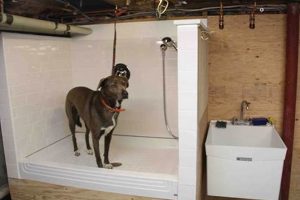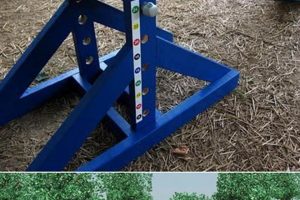Canine elevation aids, constructed by the owner to facilitate access to furniture, particularly beds, represent a solution for small, aging, or mobility-challenged dogs. These structures provide a series of steps or a ramp, allowing animals to navigate vertical obstacles with reduced strain. A typical example involves using repurposed wooden crates, securely fastened together and carpeted, to create a set of stairs leading to a bed.
The significance of these aids lies in mitigating the risk of injury associated with jumping, particularly for breeds prone to joint problems, such as dachshunds or corgis. They offer a preventative measure against conditions like intervertebral disc disease. Historically, pet owners have devised various methods to assist their animals, ranging from simple ramps made of fabric-covered plywood to more elaborate multi-tiered staircases crafted from solid wood, reflecting evolving awareness of pet health and well-being.
The following sections will examine material selection, design considerations, construction techniques, and safety protocols essential for the successful fabrication of effective and durable assistive devices for pets needing help reaching elevated surfaces.
Essential Construction Guidance
The following points provide important guidance for the creation of assistive devices for canines that may face mobility restrictions when attempting to access elevated furniture.
Tip 1: Prioritize Stability: A stable structure is paramount. Utilize robust materials and ensure secure connections between components. A wobbly aid can deter use and pose a safety hazard. Test the construction rigorously under anticipated weight loads to confirm stability.
Tip 2: Optimize Step Height: Consider the canine’s size and physical capabilities when determining step height. Steps that are too high can discourage use and exacerbate joint stress. Gradual inclines are generally preferable, particularly for smaller breeds or senior animals.
Tip 3: Incorporate Non-Slip Surfaces: Applying non-slip materials, such as carpet or textured rubber, to the step surfaces enhances traction and reduces the risk of falls. Securely affix these materials to prevent detachment over time.
Tip 4: Ensure Adequate Width: Sufficient step width allows the canine to ascend and descend with confidence. Narrow steps can create instability and increase the likelihood of missteps. A minimum width of 12 inches is generally recommended, but may vary depending on the size of the dog.
Tip 5: Evaluate Material Safety: When selecting materials, prioritize non-toxic options that are safe for animal contact. Avoid treated lumber containing potentially harmful chemicals. Consider using materials that are easy to clean and disinfect.
Tip 6: Angle Considerations: Ensure the angle of ascent is shallow enough for the dog to use the stairs without excessive strain. A steeper angle might be challenging, particularly for dogs with existing mobility issues or shorter legs.
Adherence to these principles contributes to the creation of a safe, functional, and aesthetically acceptable structure that will aid in enhancing the pet’s quality of life.
The final section will provide an overview of potential design adaptations and aesthetic considerations for integrating this aid into the existing home environment.
1. Stability
Stability constitutes a foundational element in the effective design and construction of canine stairs intended for bed access. The connection between stability and these structures directly impacts pet safety and usage frequency. Insufficient stability can lead to structural collapse, causing injury to the animal. Furthermore, a perceived lack of stability, even without actual failure, can deter the animal from using the device, rendering it ineffective. A real-world example involves stairs constructed from lightweight materials that shift or wobble under the animal’s weight, creating a hazardous and unappealing climbing experience.
Achieving adequate stability necessitates careful material selection and meticulous construction techniques. Utilizing dense, rigid materials, such as solid wood or reinforced composite panels, provides a stable base. Securely fastening individual components with appropriate hardware and adhesives prevents movement and ensures structural integrity. A practical application of this understanding involves incorporating a wide base for the stairs, increasing the surface area in contact with the floor and reducing the risk of tipping. Additionally, the use of cross-bracing or internal supports further enhances stability, particularly for taller or multi-tiered structures.
In summary, the link between stability and canine stairs is critical for both animal safety and device utility. Proper material selection, robust construction methods, and thoughtful design adaptations are essential to create a stable and reliable structure. Addressing this fundamental aspect directly contributes to the successful integration of these aids into the home environment, enabling pets to safely and confidently access elevated resting spaces. The primary challenge involves balancing the need for robustness with aesthetic considerations and minimizing overall weight for ease of movement.
2. Step Height
Step height constitutes a critical design parameter in owner-constructed canine stairs intended for bed access. The dimension of each step directly influences the ease and safety with which a dog can utilize the structure. Improper step height can lead to increased joint stress, potential injuries, and ultimately, rejection of the device by the animal. A common scenario involves stairs with steps that are too high, causing smaller breeds or senior dogs to overextend their limbs, exacerbating pre-existing arthritic conditions or leading to acute sprains. This results in discomfort and discourages further use of the stairs.
Determining optimal step height necessitates careful consideration of the dog’s size, breed, and physical capabilities. Smaller breeds and dogs with short legs generally require lower step heights to minimize strain. Gradual transitions between steps are preferred, reducing the need for excessive vertical leaps. A practical example involves measuring the dog’s leg length from paw to elbow and using this measurement as a guideline for determining the maximum acceptable step height. Adjustments can then be made based on the dog’s observed comfort level during initial trials. Furthermore, the incorporation of intermediate steps or platforms can provide additional support and reduce the perceived height difference between steps.
In summary, step height is intrinsically linked to the functionality and safety of canine stairs designed for bed access. Understanding the relationship between step height, canine anatomy, and potential injury risks is essential for successful design. Proper adjustment of step height, based on individual dog characteristics, ensures comfortable and confident use of the structure, promoting long-term adherence and mitigating potential health complications. The primary challenge lies in accommodating the needs of multiple dogs with varying sizes and abilities within the same household.
3. Non-slip Surface
The presence of a non-slip surface on owner-constructed canine stairs significantly impacts their safety and usability. A direct correlation exists between surface traction and the risk of falls or injuries during ascent and descent. Without adequate grip, a dog is more likely to slip, potentially leading to sprains, strains, or more serious musculoskeletal trauma. This risk is particularly pronounced for smaller breeds, senior animals, or those with pre-existing mobility issues. As an illustrative example, consider stairs constructed from smooth, untreated wood; these present a hazardous surface, especially when coupled with canine paws that lack inherent gripping ability on such materials. The selection of an appropriate non-slip material is, therefore, a paramount design consideration.
Implementation of a non-slip surface can involve various materials and techniques. Carpet remnants, adhered securely to each step, provide a practical and cost-effective solution. Alternatively, textured rubber mats or non-slip tape offer durable and easily cleanable options. The key is ensuring secure attachment to prevent peeling or shifting, which could create a tripping hazard. The texture of the selected material should provide sufficient grip without being abrasive or uncomfortable for the animal’s paws. Regular inspection and maintenance of the non-slip surface are essential to preserve its effectiveness over time. This might include replacing worn carpet or reapplying non-slip coatings as needed.
In conclusion, the integration of a non-slip surface is not merely an aesthetic consideration, but a fundamental safety requirement for these assistive structures. Selecting suitable materials, employing proper installation techniques, and maintaining the surface’s integrity directly contribute to the well-being of the animal. Failure to address this aspect compromises the utility of the device, increasing the risk of injury and deterring the animal from using it. The primary challenge lies in balancing the need for effective traction with aesthetic compatibility and ease of cleaning.
4. Adequate Width
The dimension referred to as “adequate width” is a critical determinant of the usability and safety of owner-fabricated canine stairs for bed access. It represents the lateral span of each step, dictating the available space for the animal to place its paws and maneuver during ascent and descent. Insufficient width can induce instability, leading to missteps and potential falls. This is especially true for larger breeds or dogs with mobility limitations, where a narrow tread restricts comfortable weight distribution. For instance, a Great Dane attempting to navigate stairs designed for a Chihuahua would be significantly compromised by inadequate step width, increasing the risk of injury.
Achieving suitable width involves considering the dog’s breed, size, and gait. Larger breeds necessitate wider steps to accommodate their larger frames and broader stance. Senior dogs or those with arthritis may require even greater width to facilitate stable and deliberate movements. A practical application involves measuring the dog’s shoulder width and adding a margin of safety to determine the minimum acceptable step width. This measurement ensures the animal has sufficient room to comfortably position its paws without feeling constricted or unstable. Additionally, the overall design of the stairs should consider the angle of ascent; steeper inclines may require greater width to compensate for the reduced surface area available for paw placement.
In summary, “adequate width” is not merely an aesthetic consideration but a fundamental component of safe and functional canine stairs for bed access. Proper width selection, guided by the dog’s individual characteristics, promotes stability, reduces the risk of falls, and encourages consistent use. The challenge lies in balancing the need for sufficient width with space constraints within the home environment and maintaining aesthetic harmony. Ultimately, prioritizing the animal’s comfort and safety through appropriate width selection enhances the overall effectiveness of these assistive devices.
5. Material Safety
Material safety represents a paramount consideration in the design and construction of owner-fabricated canine stairs intended for bed access. The selection of appropriate materials directly impacts the health and well-being of the animal utilizing the structure. Improper material choices can expose the dog to toxic substances, irritants, or allergens, leading to adverse health consequences. Therefore, meticulous attention to material composition and potential hazards is essential for ensuring the safety and long-term usability of these assistive devices.
- Toxicity of Finishes and Adhesives
Paints, stains, and adhesives commonly employed in construction may contain volatile organic compounds (VOCs) or heavy metals that pose a risk to canine health. Dogs may ingest these substances through direct contact or by licking the structure, leading to potential liver or kidney damage. For instance, lead-based paints, while historically used, are now recognized as highly toxic and must be strictly avoided. Similarly, certain adhesives contain formaldehyde, a known carcinogen. The use of water-based, non-toxic finishes and low-VOC adhesives is critical to mitigate these risks.
- Potential for Splintering or Sharp Edges
The choice of structural materials directly impacts the risk of splintering or the presence of sharp edges, both of which can cause injury to the dog. Untreated wood, particularly softwoods, is prone to splintering, while improperly cut or finished edges can present laceration hazards. For example, plywood with exposed edges can delaminate, creating sharp points. Selecting hardwoods like maple or oak, and thoroughly sanding and sealing all edges, minimizes these risks and ensures a smooth, safe surface for the animal to interact with.
- Allergenic Properties of Materials
Certain materials, such as specific types of wood or synthetic fabrics, may trigger allergic reactions in sensitive dogs. These reactions can manifest as skin irritation, respiratory distress, or gastrointestinal upset. For example, cedar wood, while often used for its aromatic properties, contains oils that can be allergenic to some canines. Choosing hypoallergenic materials, such as cotton or bamboo fabrics, and opting for non-allergenic wood species, reduces the likelihood of triggering adverse reactions. A thorough assessment of the dog’s known allergies is essential before selecting materials.
- Durability and Resistance to Degradation
The long-term durability of materials affects safety. Materials prone to rapid degradation or decay can compromise the structural integrity of the stairs, increasing the risk of collapse or failure. For example, untreated pine is susceptible to rot and insect infestation, which can weaken the structure over time. Selecting durable, weather-resistant materials, and applying appropriate protective coatings, extends the lifespan of the stairs and ensures their continued safety. Regular inspection for signs of wear and tear is essential for maintaining structural integrity.
The facets discussed above highlight the multifaceted nature of material safety considerations in the context of owner-fabricated canine stairs. Integrating these considerations into the design and construction process is not merely a matter of prudence, but a fundamental responsibility to ensure the well-being of the animal. The balance between cost-effectiveness, aesthetic appeal, and material safety must be carefully navigated to create a functional and safe assistive device.
6. Angle Considerations
The incline, or angle of ascent, represents a key ergonomic factor in the design and construction of owner-fabricated canine stairs intended for bed access. This angle directly influences the physical strain placed on the animal during use and, consequently, the likelihood of consistent adoption and mitigation of potential injuries. An improperly chosen angle can render the stairs unusable or even detrimental to the dog’s musculoskeletal health.
- Influence on Joint Stress
The angle of ascent directly affects the forces exerted on a canine’s joints, particularly the hips, knees, and ankles. Steeper angles increase the load on these joints, requiring greater muscular effort for propulsion and stabilization. This can exacerbate pre-existing conditions like arthritis or hip dysplasia, leading to pain and reduced mobility. For example, stairs with an angle exceeding 45 degrees may prove challenging for senior dogs or those with limited joint flexibility, negating the intended benefits of the assistive device. Conversely, a shallower angle distributes the load more evenly, minimizing joint stress and promoting easier ascent and descent.
- Impact on Stability and Balance
A steep angle can compromise a canine’s stability and balance during stair usage. The higher center of gravity associated with a steeper incline increases the risk of tipping or falling, particularly for smaller breeds or those with poor proprioception. This lack of stability can instill fear and discourage the animal from using the stairs consistently. In contrast, a shallower angle provides a more stable base of support, allowing the dog to maintain its balance more effectively. This improved stability fosters confidence and encourages regular utilization of the stairs.
- Relationship to Step Height and Depth
The angle of ascent is inextricably linked to both step height and step depth. A steeper angle necessitates smaller step heights to maintain reasonable vertical rise per step. However, this can result in a greater number of steps required to reach the desired height, potentially increasing the overall length of the structure. Conversely, a shallower angle allows for greater step heights but may also necessitate increased step depth to maintain a comfortable stride length. An example of an improperly configured stair design is one with a very shallow angle and short step depth, forcing the dog to take unnaturally short steps, which can also lead to joint stress. Careful consideration of all three parameters is essential for optimizing the ergonomic design of the stairs.
- Accommodation for Canine Size and Breed
The ideal angle of ascent varies depending on the size, breed, and physical capabilities of the dog. Smaller breeds and those with short legs generally benefit from shallower angles to minimize the vertical distance between steps. Larger breeds may tolerate slightly steeper angles, but excessive steepness should still be avoided. Additionally, breeds predisposed to certain musculoskeletal conditions, such as dachshunds (prone to intervertebral disc disease) or corgis (prone to hip dysplasia), require careful consideration of angle to mitigate potential strain. A customized approach, accounting for individual canine characteristics, is crucial for maximizing the effectiveness and safety of the stairs.
These facets highlight the critical role of carefully considered angle selection in the successful design and implementation of “diy dog stairs for bed.” Optimizing the angle based on the dog’s physical characteristics and health considerations directly contributes to the usability, safety, and long-term effectiveness of the assistive device.
7. Durability
The connection between “durability” and self-assembled canine stairs for bed access is intrinsically linked to the long-term utility, safety, and cost-effectiveness of the structure. “Durability,” in this context, refers to the ability of the stairs to withstand repeated use, environmental factors, and the inherent wear and tear associated with animal activity. The causal relationship is clear: higher “durability” leads to a longer lifespan for the stairs, reducing the need for frequent repairs or replacements. The absence of “durability” results in structural instability, posing a significant safety risk to the animal and negating the intended benefits of the assistive device. For example, stairs constructed from flimsy materials that warp or break under repeated weight-bearing could cause injury to the dog and necessitate costly reconstruction.
The practical significance of understanding “durability” lies in informed material selection and construction techniques. For instance, choosing hardwood over softwood for the structural frame enhances resistance to impact and compression. Employing weather-resistant finishes protects the wood from moisture damage and prevents rot. Securely fastening components with appropriate hardware and adhesives prevents loosening or separation over time. Real-world applications include using marine-grade plywood for outdoor stairs, or reinforcing stress points with metal brackets. Regular inspection and maintenance, such as tightening screws or reapplying sealant, further extend the lifespan of the stairs and ensures continued safety. Ignoring these aspects results in a compromised structure prone to premature failure.
In summary, “durability” is not merely a desirable attribute but an essential requirement for self-assembled canine stairs for bed access. It directly influences the structure’s safety, longevity, and cost-effectiveness. The primary challenge lies in balancing the need for “durability” with aesthetic considerations and material costs. By prioritizing robust materials, sound construction practices, and proactive maintenance, pet owners can ensure their self-assembled stairs provide a safe, reliable, and long-lasting solution for their animal’s accessibility needs.
Frequently Asked Questions
This section addresses common inquiries regarding self-constructed assistive devices for canines, specifically those designed to facilitate access to elevated surfaces such as beds. It aims to provide clear, concise information to assist owners in making informed decisions.
Question 1: What is the optimal angle for stairs assisting dogs in accessing a bed?
The ideal angle depends on canine size and mobility. Generally, a shallower angle (less than 30 degrees) minimizes joint stress, particularly for smaller breeds or those with arthritis. Steeper angles may be acceptable for larger, more agile dogs, but angles exceeding 45 degrees are generally discouraged due to increased risk of instability.
Question 2: Which materials are safest for canine stair construction?
Solid wood (hardwoods preferred), untreated plywood, and non-toxic finishes are recommended. Avoid treated lumber containing potentially harmful chemicals. Ensure all surfaces are smooth and free of splinters. Carpeting or rubber treads provide non-slip surfaces.
Question 3: What is the recommended step height for these stairs?
Step height should be proportionate to the dog’s leg length. A general guideline is to divide the total height to the bed by the desired number of steps, aiming for a step height that allows comfortable ascent without excessive stretching. Trial and error, observing the dog’s gait, is often necessary for fine-tuning.
Question 4: How important is non-slip surfacing on canine stairs?
Non-slip surfacing is crucial for preventing falls and injuries. Carpet, rubber treads, or non-slip tape significantly enhance traction. Ensure the chosen material is securely attached and provides adequate grip even when wet.
Question 5: Is it possible to adapt existing furniture for use as canine stairs?
Yes, repurposed items like sturdy crates or shelving units can be adapted. Ensure the structure is stable, securely fastened, and provides appropriate step heights and widths. Add non-slip surfaces for safety.
Question 6: How can the stairs be integrated aesthetically into the home environment?
Consider matching the finish to existing furniture. Upholstering the stairs with fabric that complements the dcor can also enhance their visual appeal. Thoughtful placement minimizes visual intrusion and maximizes functionality.
Key takeaways include the importance of prioritizing safety through appropriate material selection, ergonomic design, and regular maintenance. Canine-specific needs should dictate design choices.
The subsequent section will provide resources for finding design plans and construction tutorials.
Conclusion
The preceding analysis has elucidated the crucial design and construction elements essential for creating effective and safe “diy dog stairs for bed.” These elements encompass material selection, ergonomic considerations, and safety protocols. Adherence to these principles promotes the animal’s well-being by facilitating access to elevated surfaces and mitigating potential injury risks.
The construction of “diy dog stairs for bed” represents a commitment to enhancing a canine’s quality of life. It requires careful planning, precise execution, and ongoing diligence. This endeavor provides a tangible benefit to pets, and offers a meaningful demonstration of responsible pet ownership.







